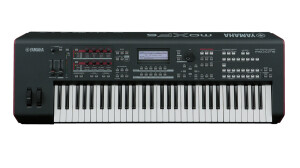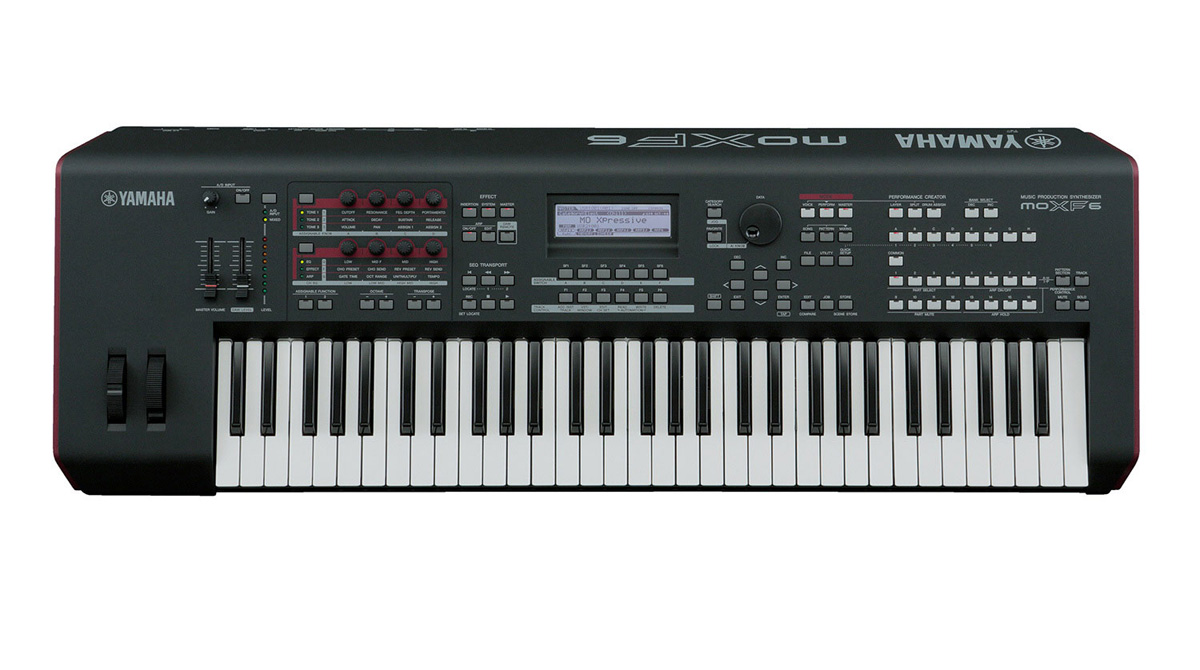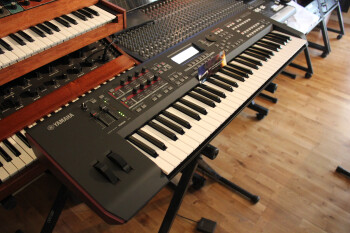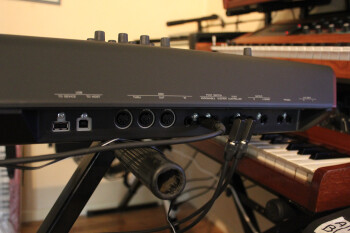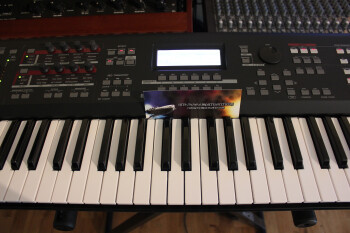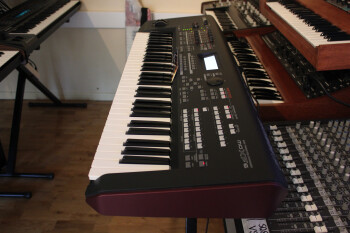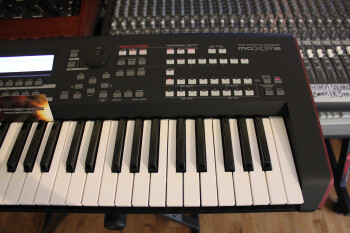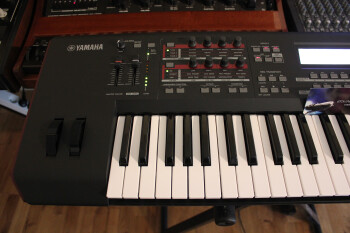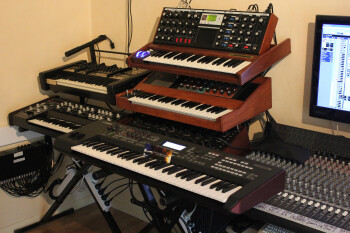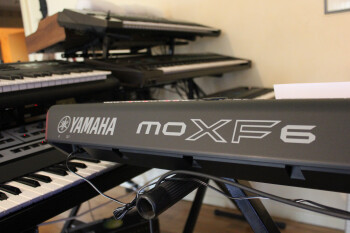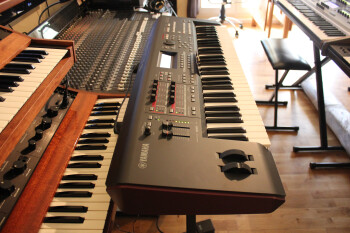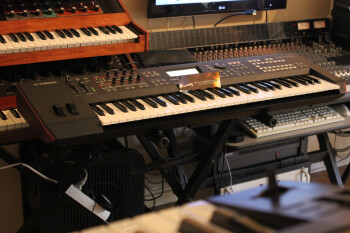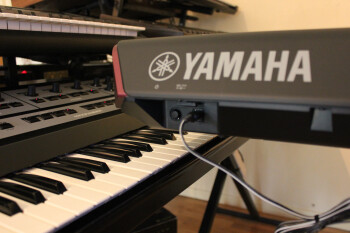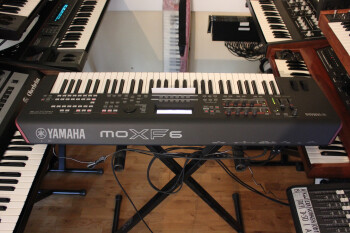Incorporating most of the sound engine of the Motif XF, the MOXF aims to redefine the standard of mid-range workstations. A sound change?
The workstation market was pretty quiet for some time, but it seems to have taken off again these last couple of years. After the Korg Kross set a new entry-level standard in early 2013, the Yamaha MOXF series made its entrance into the mid-range segment at the end of 2013, while the Roland FA series was presented at the beginning of 2014 during the NAMM show. And don’t forget Kurzweil, the “outsider, ” with the PC3K and PC3Le series, which we expect to be updated soon. Workstations concentrate functions, from samples to synthesis, things that move, effects, controls, even audio in certain cases. The main questions to ask oneself now, beyond sound, have to do with usability: Can I easily find my way among the thousands of programs? Can I rapidly create the bank I need? Can I take it on stage with a good level of reliability? Do I have enough direct controls to do a live performance without messing up in front of thousands of fans? In short, the everyday life of musicians who like all-in-one devices.
MOX outside
At first look, the MOXF has everything a MOX does: Same light weight (15.6 lbs), same construction in plastic that bends without breaking, same granular finish, same well-anchored controls on the front panel with a good response. The layout is identical: To the left, the audio section (volume and input gain controls with LEDs for monitoring of internal/external signals), real-time controls (two rows of four assignable detented encoders, two assignable modulation buttons, two octave-transposition buttons, two semitone-transposition buttons), an effects section, an arpeggios control, and transport controls (for internal sequences or an external DAW). At the center, a backlit monochrome LCD (240 × 64 dots) overhangs two rows of six buttons: One for the menu pages and another one for the sub-pages, which allows you to find your way around relatively easily. To browse, you have four arrows and a big encoder plus increment/decrement buttons.
On the right are the buttons to select the playing mode (Voice, Performance, Master, Song, Pattern, Mixing) and manage files, as well as other functions (Job, Utility and Quick Setup to quickly create multitimbral configurations). The availability of direct-access functions to create Splits, Layers and Drum Kits is a good usability feature. Finally, you have three rows of eight buttons to select the countless programs or to activate/deactivate sound layers or arpeggios, with scrolling of libraries, program lists and selection by category/subcategory. The MOXF definitely earns a point in terms of usability, considering the abundance of features available.
The 61-key keyboard of the MOXF6 we tested was pretty average, even if superior to that of the MO/MM: It was semi-weighted and velocity sensitive only. There is also an 88 weighted-key model (but no 73/76 key models).
All connections are on the rear panel: On the left, a connector for the included AC adapter and the power switch. On the right, two left/right audio inputs, a headphone output, two left/right audio outputs (everything on 1/4" jacks), three pedal connectors (two sustain/assignable switches and one assignable continuous controller), three MIDI connectors and two USB ports (to Host/to Device for audio, MIDI and backups. Nice!). Right now, if it weren’t for the burgundy color on the sides, you’d think it’s an MOX, but it’s inside where the magic happens.
Motif XF inside
The MOXF is to the Motif XF what the MOX is to the Motif XS. This time you have 741 MB of sampled waveforms (almost 4000 multi-samples and samples) with 128-voice polyphony, which is remarkable in this price range! Another remarkable point is that the sound quality doesn’t seem to have degraded with respect to the Motif XF: The levels and the presence seem similar. It’s a pleasure to discover again the musicality of the acoustic sounds, which are very consistent, in general. In terms of acoustic pianos, a generously sampled 7-ft Yamaha S6 accompanies the 9-ft CFIIIS concert piano. The former is more balanced in the mids — you can hear the sample transitions less than on the CIIIS. The array of electric pianos is very convincing, thanks not only to the excellent modeled effects (compressors, preamps, wah wah, chorus, etc.).

- Piano A Concert S6 1 02:03
- Piano A Concert S6 2 00:31
- Piano A Concert CFIIIS 1 02:04
- Piano A Concert CFIIIS 2 00:31
- Piano A Jazz 00:42
- Piano E Clavinet 00:51
- Piano E CP70 00:52
- Piano E Fender 01:11
- Piano E Wurly 00:49
When it comes to guitars and basses, the MOXF also holds its own quite well, benefiting from modeled effects and articulations that simulate different playing techniques (but certainly don’t expect the selection of huge VST libraries!)

- Guitar A 01:06
- Guitar E 01:04
- Bass A 00:17
- Bass E 01:15
- Bass F 00:32
The organs are not on par with the models some competing products offer. It’s about time Yamaha put some more effort into that (for example, integrating their own YC-3B VSTi, which is available for free). The ROM includes nice strings, both as solo instruments and as part of different stereo sections, very musical wind instruments (brasses/wood), offering different articulations, depending on the playing (velocity and the use of two switches are provided for this purpose)

- Strings 01:31
- Brass 00:33
The drums sound good, with several dynamic layers integrated into the samples, and include fabulous acoustic, hip-hop, classical, and ethnic kits. The MOXF offers a varied selection of synthesis sounds including nice-sounding basses, polyphonic groups taken from legendary analog units, and nice pads that make use of numerous multi-mode internal filters. Some Performances allow you to check that everything blends perfectly (even if reduced to four channels), thanks to the multiple insertion effects that provide different processing options. In short, the MOXF, just like the Motif XF, is one of the most consistent and musical workstations in terms of sound.

- Synth Bass 01:03
- Synth Poly 01:55
- ZPerf1 01:09
- ZPerf2 00:45
- ZPerf3 00:48
- ZPerf4 00:58
Eight layers…
The MOXF retakes the MOX synthesis architecture, which was taken from the Motif XF, which, in turn, took it from the Motif XS. So, in short, there’s not much new here. There’s a program mode called Voice based on sample playback. In normal mode you can stack eight stereo layers and in Drum mode, you can create kits of 73 notes (but without editable layers, which is plain stupid, we can’t say it enough). In normal mode, you have eight elements that can have their own key range, velocity window and routing to the effects. An element is made up of a multi-sample, filter and amp. Voices can be played in legato, in cycle, randomly, or with delay, while their pitch can be modulated by key follow and a dedicated envelope with five time-and-level parameters, which in turn is modulated by the velocity (time and level) and key follow (time).
The signal is thus injected into the filter, which is multi-mode and resonant. You will find again the 18 algorithms (high-pass, low-pass, band-pass, band rejection) with different slopes (4, 3, 2, and 1 poles) and different colors (analog modeling that smooths the edges, digital modeling with high resonance, hard, soft). There are even combinations in series and in parallel, so there’s something for everybody. The velocity can modulate the cut-off frequency and resonance, while the cut-off frequency can also be modulated by the key follow, a dedicated envelope with five time and level parameters (identical to the previous one), and a four-point tracking generator. Then the output of the filters passes through an amp with a dedicated envelope with four time and level parameters, a four-point tracking generator and pan modulation (key follow, random). Other modulations at the element level include an LFO with three basic waveforms that acts on the pitch, the filter and the amp, followed by a simplified EQ (two semi-parametric bands, one parametric band or +6dB /+12dB /+18dB boost). All that for a single element!
…In the program
|
At the global level, the program has many other parameters: Categories (main and secondary), volume, pan, pitch, polyphony, pitch bend, portamento, temperament (13 presets), and assignment of the two encoders and buttons. There’s also a modulation matrix with six patches, which allows you to relink physical controllers to destinations (more than a hundred, including most synthesis parameters and insert effects), a very sophisticated global LFO, an arpeggiator and two insertion effects (to which we will come back later). What Yamaha workstations lack in terms of synthesis are audio inter-modulation possibilities between the elements of a program.
A brief remark on the Drum mode, where you can define, for each of the 73 assignable keys, the PCM sample, the pitch (which can be modulated by the velocity), the triggering mode (exclusive, note off, sustain), the assignment to both insertion effects, the send level to the two master effects, the low-pass cut-off frequency (which can be modulated by the velocity), the resonance, the high-pass cut-off frequency, the volume (which can be modulated by the velocity and an envelope with three time and two level parameters), the pan (fixed, auto-sweep, random), and the EQ (identical to normal mode). Common parameters are very simplified versions of the normal mode. In total, the MOXF includes 1664 programs (including 384 user ones) and 105 Drum kits (including 32 user ones).
Four max
As usual with Yamaha workstations, programs are arranged in groups of four. Once again, nothing new here: Competing products do much better. You’ll find a Performance mode identical to the one on the MOX: Four parts, each with its own MIDI channel, re-configurable synthesis parameters (some of them modifiable with the real-time controls), mix parameters, etc.
The audio input is added to the four parts with some very welcome settings. The settings of the four channels can be exported into a Pattern or a Song (see below). You can also record the playing of a Performance as a Pattern or a Song, the tracks being immediately configured and the notes sent to the right location. The memory comprises 256 factory pre-loaded Performances. We appreciate that everything can be adjusted and synced perfectly (phrases, arpeggios, etc.), but eight channels would’ve been better, especially considering that the insertion effects increased to eight groups of two in multitimbral mode, as you will see in a moment.
New arpeggios
The MOXF retakes the Motif XF arpeggiators, while incorporating some new additions, for a total of 7981 arpeggios in ROM, classified into 16 categories and 24 subcategories. Some are complex polyphonic phrases, others are percussion patterns, some others recall the Megavoices, multi-layer samples that reproduce the subtle nuances of acoustic instruments. The only problem in this last case is that it can’t be played live, you will have to play the associated arpeggio and Megavoice. The realism of the arpeggiator is also due to the fact that MIDI events are used in addition to the notes: Modulation of synthesis parameters, mixing, playing zone, velocity, chords, swing. The ROM arpeggios differ depending on the program type (normal or Drum).
You can also create your own arpeggios and save them into one of the 256 memories. You can use up to four 16-note tracks, based on one of the sequencers (Pattern or Song), to that end. Every program is recorded with from one to six arpeggio variations, which you can chain seamlessly with the function buttons below the screen. In multitimbral mode, you have four simultaneous polyphonic arpeggiators at your disposal. For the Pattern or Song modes with 16 tracks, you have to choose the four channels to which the arpeggios will be assigned, as simple as that.
Unchanged sequences
The MOXF presents no changes when it comes to sequencers, it simply inherited the excellent architecture used in its ancestors. You have two playing and recording modes: Pattern and Song. 16 MIDI channels, a tempo track, playing scenes and a total of 226,000 MIDI events, with a resolution of 480 ppq.
The Pattern mode has a maximum of 256 measures, made up of 16 sections of 16 looped tracks. You can fill the 16-track sections as if it were a 16 × 16 matrix. The sequences can be defined by chaining steps, where each step memorizes the number of the section played and the active tracks. The result can be sent to a Song where it will be read from A to Z. The Pattern mode allows you to record in real time or step by step. In real time, you have all classic and very useful functions: Punch in / out, Loop, Overdub / Replace, quantize. Even the arpeggiator can be used and recorded on the fly. Once recorded, you can edit the Pattern globally or by list, with per-event access, in which case you have access to insert/delete, transposition, Glide/rolls, remix, cut, and MIDI CC editing. In terms of memory, you have 64 Patterns to immortalize your works.
The Song mode offers an alternative approach to the Pattern mode, since it’s linear, rather than in blocks. However, sequences can be looped, with each track having its own length. There are also mixing and chain functions, real-time or step-by-step recording, and microscopic editing by list. In terms of memory, you have 64 songs at your disposal. Finally, the Mixing mode allows you to configure the 16 channels on the fly: Programs, MIDI In channel, key range, velocity, mixing, and effects (assignment to the two insertion effects and sends to the chorus/reverb effects). As in Performance mode, the audio input is configurable, as a sort of 17th track. It’s also in Mixing mode that you can edit the programs by switching to the Voice editor. The MOXF allows you to save 256 additional programs (“Mixing voices”) and assign them to any channel, in order not to overwrite original programs, cool!
Demultiplied effects
|
The MOXF uses the same effects as the MOX, but they have multiplied in the multitimbral modes. A program features two insertion effects, two system effects (chorus and reverb), one master effect (for all programs), and a master EQ (for all programs, too). The VCM modeled effects are obviously part of the lot, which is great for the electric pianos, basses and guitars. The two insertion effects (A and B) are the most powerful, with 54 complex algorithms (up to 16 parameters) that can be modulated in real time. On the menu you have reverbs, delays, ensembles, compressors, amp simulators, distortions, EQ, signal destruction effects, and chained effects. Effects A and B can be placed in series (A -> B or B -> A) or in parallel. A vocoder, which takes up the two blocks, allows to process internal sounds (carrier) via the audio input (modulator). There are 10 bands with compression/gate at the input, formants delay, noise, HPF, and separate gains for the bands.
Global effects are effect groups: For the Chorus you have 22 chorus, flanger, phaser, and reverb algorithms. For the Reverb you have nine reverb and complex delay algorithms, including some taken from the SPX2000. You can control the chorus send to the reverb and the returns of the two buses, with separate pans. The global master effect features nine algorithms: Delays, compressors and destruction effects, in order to color the final sound in a more or less subtle manner. The global EQ, at the end of the chain, is five-band parametric (Peak/Shelving for the mid bands and Shelving for the upper and lower bands). In multitimbral mode, you have eight blocks of A+B insertion effects (the MOX was limited to three), which means up to 16 multi-effects. Thus, you can separately process the four channels of a Performance and eight tracks (out of the 16) of a sequence, which is impressive in this price range. And you still have to add to that a three-band EQ per channel, and two system effects (chorus and reverb) with two separate sends per channel, the master multi-effect and master EQ. The two latter are memorized within each Performance or sequence. An awesome section!
Guard changed
We liked the MOX when it came out, so how can we not like the MOXF more? Twice the PCM memory, twice the polyphony, a more powerful effects section, and a Flash Ram option for external sound libraries. In short a condensed Motif XF for a fraction of the price, minus the sampling function. And don’t forget the strengths inherent to the series: Consistent sound quality, well-equipped arpeggios and sequences, audio and MIDI over USB, lightweight. Even though it does have some rare defects: The plastic construction, an average keyboard, a reduced screen, and Performances limited to four channels. But none of these are deal-breakers considering the price. Here you have a mid-range workstation that has a lot of features of a high-end product, among which is the sound quality. Once again, the changing of the guard has been successful!
Download the audio files (in FLAC format)


